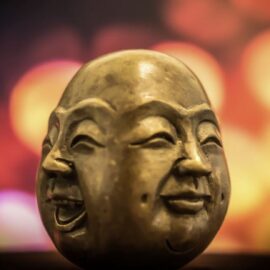

This article is an excerpt from the Shortform book guide to "The Monk Who Sold His Ferrari" by Robin Sharma. Shortform has the world's best summaries and analyses of books you should be reading.
Like this article? Sign up for a free trial here .
Are you looking for focus-improving exercises to gain control over your thoughts? What exercises do Sharma recommend in his book The Monk Who Sold His Ferrari?
In Robin Sharma’s famous book The Monk Who Sold His Ferrari, the main character John learns from Julian how to control his thoughts. Julian explains three practices: The heart of the rose, opposition thinking, and visualization.
Here’s the explanations of Julian’s exercises along with further analysis and examples.
John Learns Exercises to Improve His Focus
While listening to Julian, John confesses that he has little control over his own thoughts these days. He’s stressed, and he feels like he’s constantly pulled by one task after another.
Julian agrees with John’s assessment, and he says that the mind is like a muscle: You have to exercise to make it stronger. He promises that a single month of dedicated effort will be enough for John to see huge changes in his life—just 10 minutes a day spent meditating on his current circumstances, how he’ll make the next day better, and his purpose in life is enough to start. Also, Julian mentions that the less John worries about results, the faster he’ll get them.
Julian repeats the one-month timeframe, and this time adds that John can start by taking small steps (like meditating for just 10 minutes each day). Small steps leading to big outcomes is another lesson that you’ll see in many different schools of thought; therefore, it’s something that people with a wide variety of backgrounds and ways of thinking can all agree on. In Minimalism, the authors repeatedly stress that making small improvements each day will lead to the happy, fulfilling life that you want. The famous proverb “A journey of a thousand miles begins with a single step” comes from the Tao Te Ching, a core book of Taoism. In Chapter 9 of the book, Sharma himself will discuss kaizen: the practice of making daily, incremental improvements.
Here are Julian’s focus-improving exercises:
Exercise #1: The Heart of the Rose
John asks for practical techniques that he can use, so Julian teaches him a meditation technique called the Heart of the Rose. You can do this exercise yourself, with nothing but a rose and a quiet space.
Take your rose and stare at the center of the flower. Think of nothing but the rose. Notice its color, shape, scent, and even its texture.
Other thoughts will intrude at first. Accept them, and return your attention to the rose. With practice, those intrusive thoughts will come less frequently, and eventually stop completely as you strengthen your mind and your focus.
| The Heart of the Rose is Sharma’s take on the classic candle meditation. In a candle meditation, you light a candle and stare at it. While doing this, you focus completely on the candle’s flame; any thoughts that aren’t related to observing the candle should be acknowledged, and then immediately dismissed. Over time, you should find that fewer and fewer thoughts intrude on your meditation. Whether you’re looking at a flower or a candle flame, the purpose is to practice focusing on a single thing while shutting out unrelated thoughts. |
Exercise #2: Opposition Thinking
A second powerful technique Julian teaches John is Opposition Thinking: Whenever a negative thought occupies your mind, dismiss that thought and replace it with a positive one. It’s a simple exercise, but it requires persistence and vigilance to be effective. Try not to let even a single negative thought take root in your mind.
| Opposition Thinking Application: Multitasking vs. Flow Opposition Thinking works because the human mind can only focus on one thing at a time—studies show that multitasking is a myth. Opposition Thinking takes advantage of that fact by intentionally focusing your attention on positive thoughts, rather than negative ones. If you’d like more detail on how to practice Opposition Thinking, note that it’s a simplified version of Cognitive Behavior Therapy (CBT). CBT is a process where you learn to recognize and examine irrational negative thoughts (for example: “I failed that test, so I’m stupid and worthless”) and to replace them with more positive, realistic thoughts (like, “One test doesn’t define my life; I’ll do better next time”). With CBT, you examine your thoughts using questions like What evidence is there that this thought is true? What evidence is there that it’s false? How else could I think about this situation? If a friend had this thought, what would I say to him or her? Opposition Thinking is a more streamlined process; you simply recognize the negative thought and dismiss it by thinking of something else, effectively skipping all of the in-between steps of CBT. However, if you find that you’re truly struggling to control your negative thoughts, you may find it useful to go through the full process of CBT—with professional help, if necessary. |
Exercise #3: Visualizing Your Ideal Self
Find a quiet place, close your eyes, and simply breathe until you feel calm and your mind is clear. Then visualize, as clearly as you can, the person you want to be. For example, if you want to be happy, see yourself laughing and smiling. If you want to be brave, see yourself acting boldly at a decisive moment.
This exercise is grounded in the idea that your mind attracts what you think about. Therefore, if there is a lack in your life, it’s because there is a lack in your thoughts. This exercise is designed to make sure that you’re attracting the right things.
While teaching Julian, Yogi Raman called this phenomenon of attracting what you think about joriki, which means “concentrated mind.”
| Joriki and the Law of Attraction Joriki is a concept in Zen Buddhism. It describes the ability to act instantly and correctly, apparently without thought, when your mind is fully focused on a single objective or idea. Sharma is merging joriki with the Law of Attraction: the idea that positive thoughts attract positive experiences. The Law of Attraction came from the New Thought movement of the late 19th century; more recently, Rhonda Byrne repopularized the idea with her 2006 movie The Secret, and the book of the same name, published in 2007. In combining the concepts of joriki and the Law of Attraction, Sharma is saying that by focusing your mind entirely on one specific thing that you want, you’ll attract that thing into your life. However, others argue that you don’t “attract” the things you think about—you simply start to notice them. For example, in his book Limitless, Jim Kwik talks about setting your brain to look for relevant information by asking a dominant question. Kwik says that whatever you’re looking for has always been there, but dominant questions prepare your mind to notice it. Some readers may also recognize this principle by its more scientific name, the Baader-Meinhof Phenomenon. |

———End of Preview———
Like what you just read? Read the rest of the world's best book summary and analysis of Robin Sharma's "The Monk Who Sold His Ferrari" at Shortform .
Here's what you'll find in our full The Monk Who Sold His Ferrari summary :
- Why your career success might actually be killing you
- How to live a simple and fulfilling life
- The 10 rituals you should practice for health and healing






